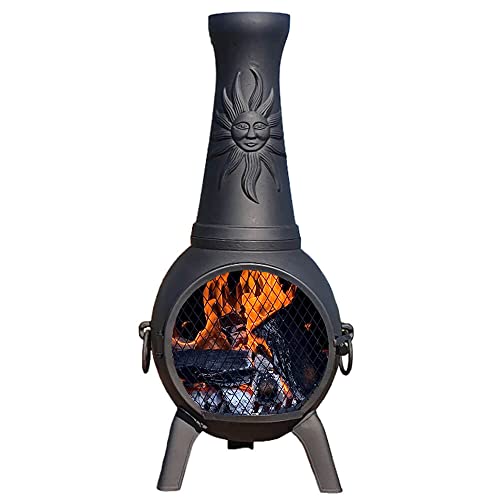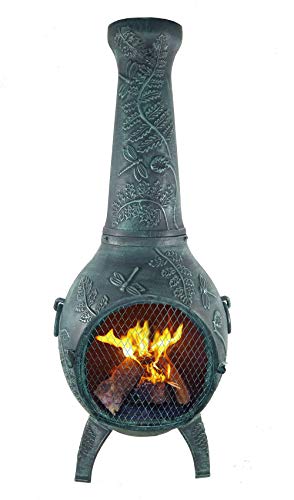10 Things That Your Family Taught You About Mexican Chimineas
페이지 정보
작성자 Denisha 작성일 25-02-13 04:52 조회 9회 댓글 0건본문
 Chimineas - An Authentic Mexican Fire Pit
Chimineas - An Authentic Mexican Fire PitOriginally used as a bread oven, chimineas reflect Mexico's rich cultural heritage. The timeless design blends practicality and aesthetic simplicity.
 Clay chimineas can be fired in kilns, which remove organic matter from the clay and seals the pores to avoid cracking. They can be utilized outdoors all year however they shouldn't be exposed to the elements for too long.
Clay chimineas can be fired in kilns, which remove organic matter from the clay and seals the pores to avoid cracking. They can be utilized outdoors all year however they shouldn't be exposed to the elements for too long.Origins
Imagine a balmy summer evening with your family and friends, enjoying delicious food in an outdoor space, surrounded by the gentle heat from your clay or Mexican chiminea. It's a picture like the Mexican origins of this type of outdoor firepit.
These traditional terracotta stoves were designed to function as radiant heaters as well as ovens. They were used to help tribesmen endure the cold winter nights in their homeland. Their distinctive design was derived from their utilitarian qualities that emphasized practicality and the importance of living in a communal setting.
These stoves were initially constructed from natural terra-cotta clay which was dried and then wood-fired in kilns. Chimineas made of clay are more rustic and do not have a glazed surface to protect them. Modern manufacturers make chimineas using metals like cast iron, brass and aluminum. These materials provide enhanced durability and weather resistance which addresses one of the major weaknesses of the clay design.
The unique design of the chiminea for sale near me was influenced by a pot-bellied base that rises to an elongated fireplace. This form is a perfect way to contain fire while also directing smoke upwards, which reduces air inhalation and maximizes heat retention.
Chimineas were used by Mexican tribes for heating, cooking and lighting. We can still enjoy their design and the warmth they provide in the cold autumn evenings or even in the cold winter sun.
Gardeco provides a variety of styles that will fit your garden. We offer a variety of sizes, ranging from small to extra-large. We also have clay chimineas with decor which is either moulded or engraving into the body of the product.
Our range of terracotta chimineas and Mexican Chimineas is made by artisans in the middle of the country. The process of manufacturing can result in small variations in the shape and colour. It is possible to repaint your chiminea using an emulsion paint that's water-based if it starts to discolour. It is essential to follow the manufacturer's instructions and care guidelines prior to using your new chiminea for the first time.
Design
Chimineas not only add character and warmth to any space They are also useful. They are available in a variety of designs and materials. They can be matched to any patio furniture. They can be a focal point or blend in seamlessly with the surroundings.
The traditional chimenea, constructed of clay, was created with both practical and cultural significance in mind. Its chimney-like neck was tall and directed smoke away from users, while its rounded body radiated heat. It was also used to socialize and tell stories, which played an important place in Mexican and Central American cultures.
Traditional chimineas are handcrafted by local artisans using moist clay that is taken directly from the earth. The raw material was formed into its final form before being dried in a kiln. Clay chimeneas can be extremely labor intensive to make especially big ones. The chiminea's bowl and neck are made by smoothing long snakes of clay that have been rolled. The clay's rim was often decorated with carvings and patterns.
A modern chiminea is usually made of metal such as cast iron or aluminum. Metal chimineas are an important improvement because they could endure high temperatures and moisture without cracking. This modification allowed chimineas to be used in many different climates.
Metal Chimineas are most commonly used but there are certain companies that make clay and terracotta ones. Metal chimineas last longer and are easier to clean. These features have made chimineas made of metal more popular than their clay counterparts.
Whatever type of chiminea indoor that you select it's important to place it in the proper location. It must be placed in a leveled space far from any fire pits & chimineas-prone objects like trees, grass or other buildings. The chiminea indoor must be placed on a brick, concrete, patio or stone terrace and not on a deck made of wood. It's also recommended to place 50mm of sand or Gardeco lava stones under the chiminea to protect it from direct heat and to keep the most hot part of the fire away from the clay.
Materials
Traditional clay and terracotta chimineas which are still manufactured by small factories in the present, are fired to temperatures up to 1000c. After they have cooled and dried, the chimineas are able to be put together. Some are glazed, while others remain unglazed. Chimineas can give an Mexican feel in a garden.
Chimineas are usually hand Mexican chimineas painted, with various colours and designs to suit the various styles. The paint finish does discolour due to time and heat of the fire, so it's best to re-paint with a water-based emulsion.
Originally designed to provide heating and cooking facilities for Mexicans living in towns, chimineas through the years have evolved into a cultural symbol, adapting their function to meet a variety of needs. These distinctive structures weren't solely used by indigenous peoples of Mexico as bread ovens as well as played a significant role in repelling bugs and promoting social gatherings.
The unique design of the chiminea's chiminea with its broad base and narrow chimney spout allow maximum air flow into the structure from the bottom, minimizing smoke intake. It also helps to retain the heat inside the chiminea, making it ideal to cook over.
Currently, chimineas are available in a wide range of materials, including terracotta, cast iron, and even aluminum. Terracotta Chimineas have the classic Mexican style. They are susceptible to cracking when under pressure and should only be placed on a flat surface that is safe from fire. Cast iron and aluminum chimineas have less risk of damage but are still attractive and sturdy.
To make sure the chiminea lasts as long as possible, you should keep it in a place which is well ventilated and shielded from rain and wind. It should be kept away from any walls or structures that might catch alight and also any roofs on patios or eaves that may be damaged due to the sudden change in temperature that occurs when the chiminea's flame is completely extinguished. To ensure that the chiminea does not smoke excessively it is recommended that only dried, seasoned logs are burned. It is important to clean the chiminea frequently with a wirebrush, as this will help prevent the build-up of deposits that may be burned and turn black. Sheltering the chiminea from the winds will also help reduce the amount of smoke that it emits as it burns.
Maintenance
As with any fire equipment the proper maintenance is crucial to ensuring the longevity of your chiminea. This will help to extend its life and ensure that it operates safely. Chimineas are fragile and should be kept outdoors in a place where they can be taken care for. Even though a clay chiminea appears sturdy however, it could still crack and break from a variety of sources. It is important to check your chiminea for signs wear and adhere to the manufacturer's recommendations on how often you should start it up.
To keep your Mexican chimney looking good, you should clean it thoroughly using a mild detergent. This will remove any built-up dirt and grime that can lead to discoloration and rust. A wire brush should be used to scrub away the rusty particles that are floating around, and it is also recommended that you wear gloves and goggles for safety reasons. After scrubbing your chiminea clean then rinse it and allow it to dry completely. This will stop any moisture causing corrosion and can greatly prolong the life of your chiminea.
After your chiminea is cleaned and dried, it can be lightly sanded using fine-grit sandpaper. This will smooth the surface and eliminate any rough spots that might catch embers when you build an fire. The sanding can also help to make the surface more uniform and attractive. In the end, sanding could be followed by several coats of stove or grill paint, which will improve the appearance of your chiminea and guard it from corrosion.
Keep your chiminea from direct sunlight and wind, as this could cause paint to peel and fade. You can easily solve the issue by using water-based emulsions or paints or masonry sprayed. It is also important to only use small fires and add only a few logs at a time to your chiminea in order to get it "broken in" and to avoid overheating.
- 이전글5 Buy B2 Certificate Projects For Any Budget
- 다음글The Top 5 Reasons People Win In The Buy Clovis Yorkshire Terrier Industry
댓글목록
등록된 댓글이 없습니다.


